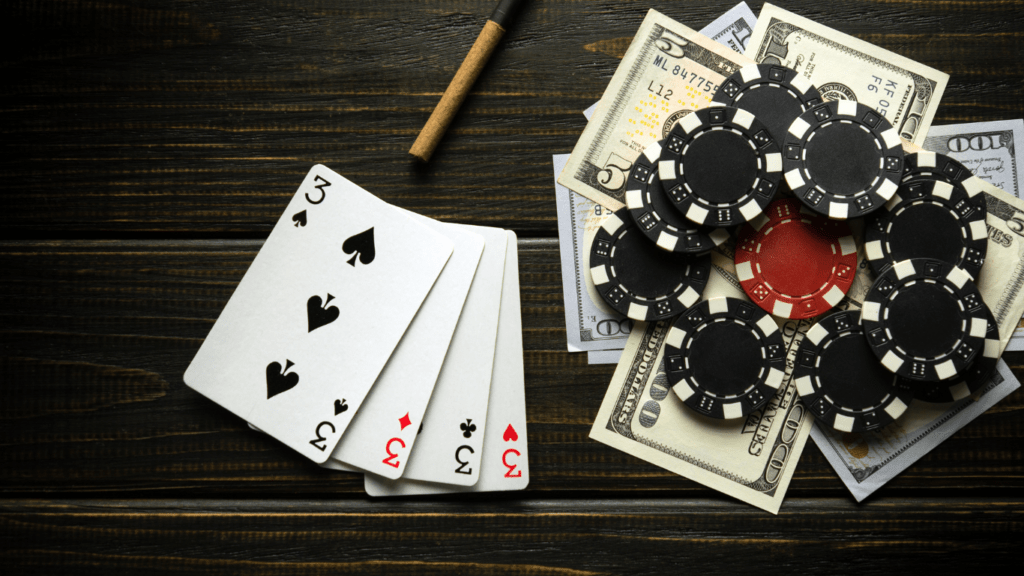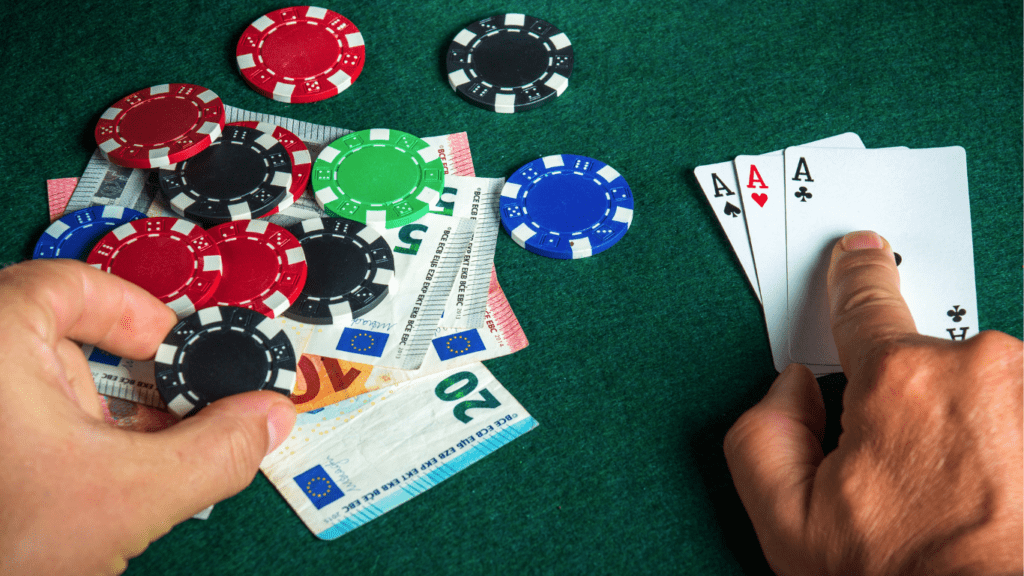Understanding Poker Hands
Poker hands rank from high to low, and knowing the value of each can make or break a game. Each poker hand combination has a specific rank that determines its value compared to other hands.
- Royal Flush
A Royal Flush is the highest-ranking hand, consisting of Ace, King, Queen, Jack, and Ten, all of the same suit. It’s unbeatable and a rare occurrence.
- Straight Flush
A Straight Flush combines five consecutive cards of the same suit. For example, 5, 6, 7, 8, and 9 of hearts. It’s the second-highest hand. - Four of a Kind
Four of a Kind, or Quads, includes four cards of the same rank. Example: four Queens. The fifth card, known as the kicker, breaks ties.
- Full House
A Full House contains three of a kind plus a pair. For instance, three Kings and two 5s. It ranks below Four of a Kind yet above a Flush.
- Flush
A Flush consists of five cards of the same suit, not in sequence. An example is Ace, 10, 7, 3, and 2 of clubs. Higher ranked cards determine the winner in a tie.
- Straight
A Straight comprises five consecutive cards of different suits. Example: 4, 5, 6, 7, and 8 of mixed suits. Ties are decided by the highest card in sequence.
- Three of a Kind
Three of a Kind means having three cards of the same rank. Example: three Jacks. The remaining two cards, or kickers, settle ties.
- Two Pair
Two Pair involves two distinct pairs of cards, such as two 8s and two 4s. The fifth card determines the winner in case of a tie.
- One Pair
One Pair includes two cards of the same rank. Example: two 9s. The other three cards, or kickers, resolve ties.
- High Card
When no other hand is made, the highest card wins. Example: Ace high. It ranks the lowest among poker hands.
The Importance Of Hand Rankings

Knowing the value of different poker hands is crucial for making strategic decisions in the game. Each hand ranking determines the potential of winning the pot.
High Card
A High Card hand relies solely on the highest card in a player’s hand. If no player holds a pair or better, the highest card wins. For example, in a hand with cards like K-8-5-3-2, the King is the High Card. High Card hands are often weak and typically used to fold unless in specific strategic contexts.
One Pair
One Pair involves two cards of the same rank with three unrelated cards. For instance, a hand with Q-Q-7-5-2 forms one pair with Queens. One Pair hands are moderately strong in some games and scenarios, acting as a solid foundation for betting cautiously or folding if faced with aggressive raises.
Two Pair
Two Pair consists of two different pairs and an unrelated card. An example of this would be A-A-K-K-6. Two Pair hands generally provide better standing than a single pair and can warrant more confident betting. Folding with a Two Pair might be prudent if the board shows potential for higher-ranked hands.
Three of a Kind
Three of a Kind features three cards of the same rank with two unrelated cards. For example, a hand with 5-5-5-J-9. This hand ranking is stronger and often encourages more aggressive betting. However, folding should be considered if the board suggests the possibility of a straight or flush.
When to Fold
In poker, knowing when to fold is as crucial as knowing when to bet. Making the right decision to fold can save your chips and improve your long-term game.
Recognizing Weak Hands
Identify weak hands early by evaluating their potential. Hands like unsuited, unconnected cards (e.g., 7-2 offsuit) offer little chance of forming strong combinations. Low-ranked pairs (e.g., 2s or 3s) might seem promising but often lose to higher-ranked hands with community cards. If the board shows possibilities of better hands (like straights or flushes), folding these weak hands minimizes risk.
Assessing Your Position
Your position at the table significantly impacts your decision to fold. If you’re in an early position, you’re at a disadvantage because you must act without knowing your opponents’ moves. In this case, fold marginal hands to avoid potential traps. Conversely, in a late position, observe the actions of others before deciding. If multiple players show strength through raises, fold weaker hands unless you hold a high-potential hand to counter their bets. Avoid getting entangled in costly pots with subpar hands.
When to Bet
Knowing when to bet can significantly impact your success in poker. Strategic betting relies on identifying strong hands and reading opponents’ behaviors to maximize your winnings.
Identifying Strong Hands
Strong hands should always encourage betting. These include:
- Royal Flush: An unbeatable hand consisting of A, K, Q, J, and 10 of the same suit.
- Straight Flush: Five consecutive cards of the same suit, like 5-6-7-8-9 of hearts.
- Four of a Kind: Four cards of the same rank, such as four Aces.
- Full House: A pair and a three of a kind, e.g., three Kings and two Tens.
- Flush: Five cards of the same suit, not in sequence.
- Straight: Five consecutive cards of different suits.
- Three of a Kind: Three cards of the same rank, like three Jacks.
Bet aggressively with these hands, as they are highly likely to win the pot. Consider the card combinations on the board to ensure no stronger hands are possible before committing.
Reading Opponents
Understanding opponents’ behaviors can drastically inform my betting decisions. Key factors include:
- Betting Patterns: Frequent large bets indicate strong hands or a bluff. Smaller, consistent bets suggest medium-strength hands.
- Body Language: Physical tells like shaking hands, rapid breathing, or excessive blinking often reveal nervousness or excitement.
- Timing: Quick bets after the flop might indicate confidence or a strong hand. Hesitation often signifies uncertainty or weakness.
Utilize these insights to decide the optimum betting strategy, adjusting based on opponents’ displayed tendencies and the strength of my own hand.
Bluffing Strategies
Bluffing forms an integral part of poker, blending psychology and strategy. Utilizing bluffing correctly can mislead opponents and win hands with weak cards.
When to Bluff
Consider bluffing in specific situations to gain an advantage. If the board shows high cards but your hand is weak, a well-timed bluff can convince opponents you have a strong hand. Position plays a crucial role; bluffing from a late position allows you to read your opponents’ actions before acting.
Bluff effectively if you notice that your opponents often fold under pressure. Avoid bluffing against players who rarely fold; they are likely to call your bet without hesitation. Disciplined bluffing, with specific conditions met, elevates the chances of success.
Signs Your Opponent Is Bluffing
Identify opponent’s bluffs by observing specific behaviors. Fast betting often signals nervousness, indicating a possible bluff. Look for inconsistencies in betting patterns; sudden large bets after a series of small ones may mean they’re bluffing. Unnatural body language, like avoiding eye contact or excessive fidgeting, can also suggest a bluff.
Pay attention to the timing of bets; a quick bet with little consideration suggests they’re trying to intimidate without strong cards. Recognizing these signs lets you call their bluff and potentially increase your winnings.


 Michaello Thomasters, the visionary founder of Bet Roll Gamble, has built a dynamic platform that serves as a hub for betting enthusiasts across various arenas, including sports, poker, horse racing, and esports. With a passion for providing valuable insights and strategies, Thomasters aimed to create a space where both novice and experienced bettors can enhance their skills and stay ahead of trends.
Michaello Thomasters, the visionary founder of Bet Roll Gamble, has built a dynamic platform that serves as a hub for betting enthusiasts across various arenas, including sports, poker, horse racing, and esports. With a passion for providing valuable insights and strategies, Thomasters aimed to create a space where both novice and experienced bettors can enhance their skills and stay ahead of trends.